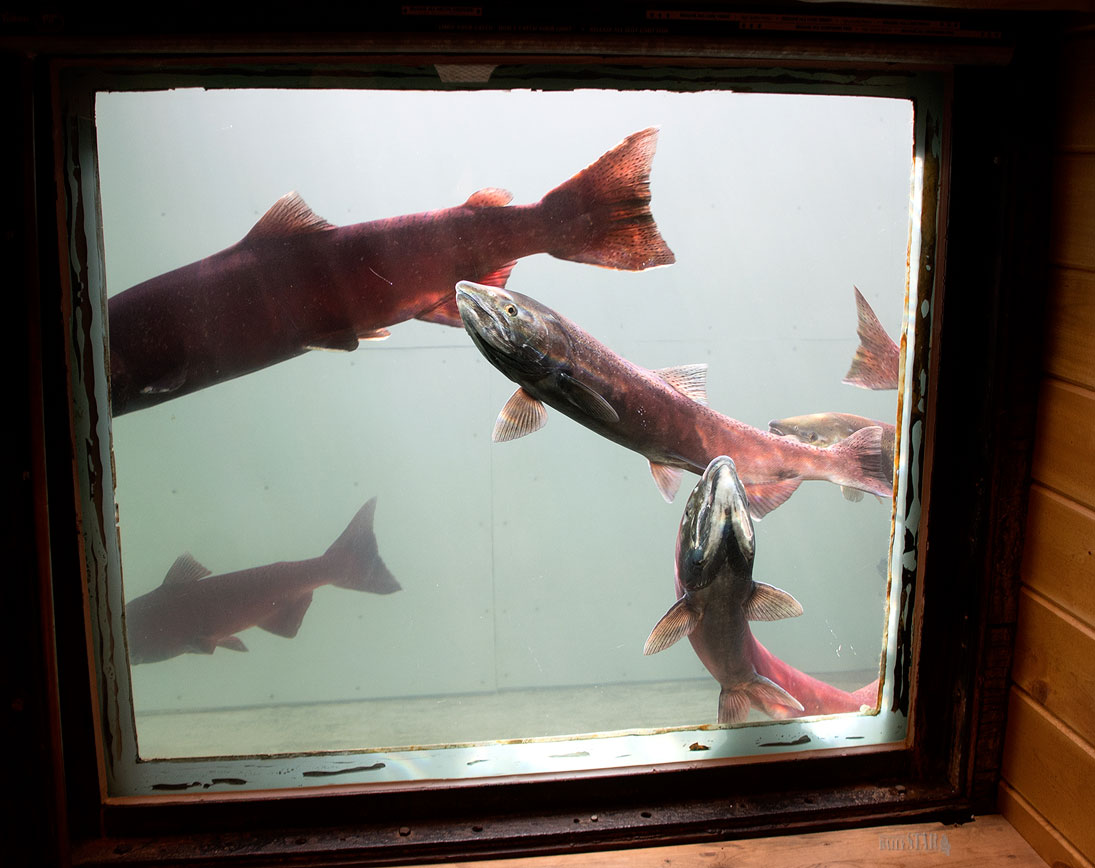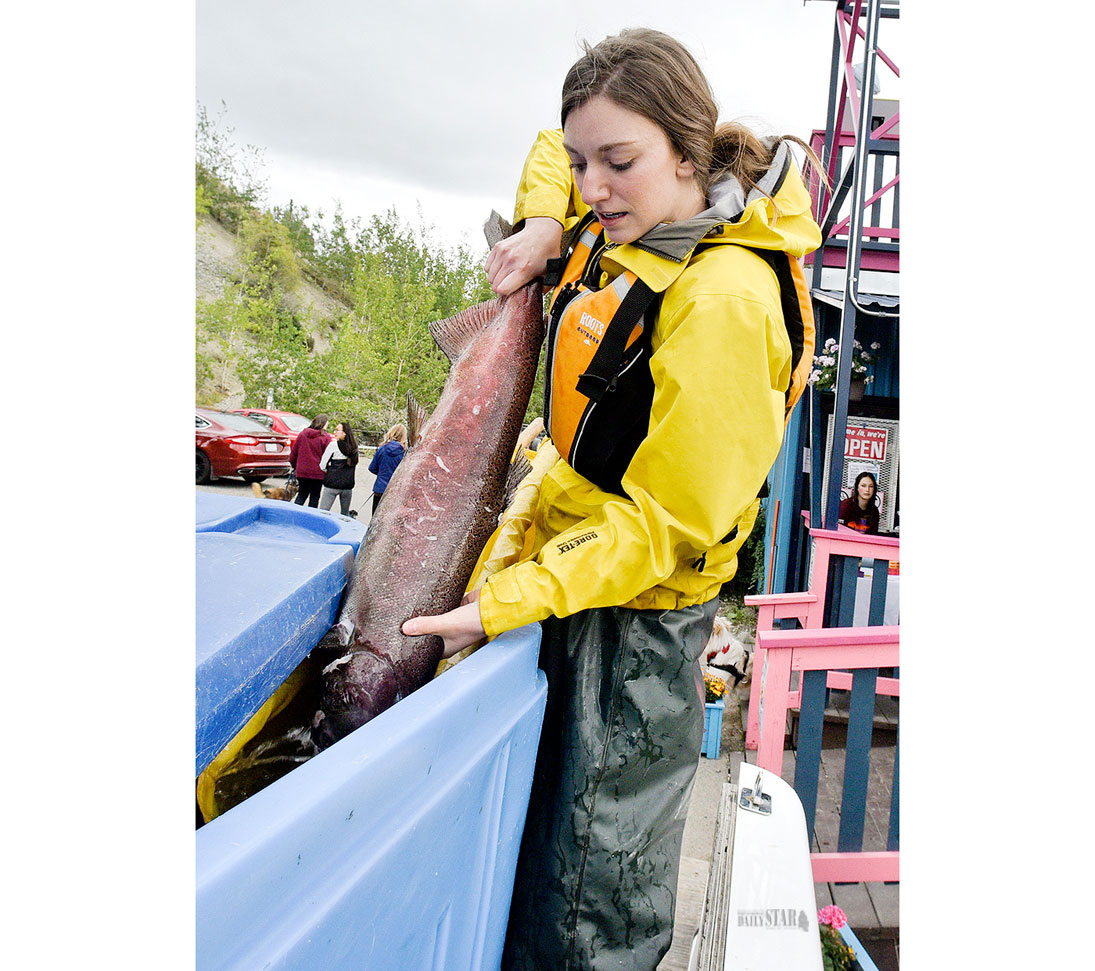
Photo by Vince Fedoroff
TIME TO EXPLORE – Salmon swim in the Whitehorse Rapids Fishway tank in August.

Photo by Vince Fedoroff
TIME TO EXPLORE – Salmon swim in the Whitehorse Rapids Fishway tank in August.

Photo by Vince Fedoroff
THERE YOU GO – Emilie Major-Parent places a salmon in the tank at the Whitehorse Rapids Fishway during the facility’s annual Appreciation Night last month.
The Whitehorse Fish Ladder closed Monday – but not until after 22,290 visitors had checked out the popular attraction over the summer.
The Whitehorse Fish Ladder closed Monday – but not until after 22,290 visitors had checked out the popular attraction over the summer.
Visitation this summer was up from the 20,959 people who dropped in last year, according to records.
With this summer’s run of Yukon River chinook salmon all but over, the count as of Wednesday showed 1,226 chinook going through the ladder.
That’s down from 1,556 last year but a hair above the annual average of 1,200.
Of the total count, 905 or 74 per cent were male and 321 or 26 per cent were female.
Of the 905 males, 523 or 58 per cent were reared in the wild and 382 or 42 per cent were reared at the Whitehorse Fish Hatchery.
Of the 321 females, 227 were reared or 71 per cent were reared in the wild and 94 or 29 were reared at the fish hatchery.
“So our count is lower than last year, overall, but it’s looking better in terms of the the number of females,” ladder supervisor Emilie Major said in an interview Wednesday.
“Even if our numbers are lower, our ratio is better, and we have much more wild than hatchery.”
Last year’s total count was 1,556, and only 18 per cent were female.
The annual return of chinook salmon varies dramatically, though the expectation was for a higher count this year because of the preseason forecast for a strong return.
The robust run did materialize, but there were also larger subsistence food fisheries on both sides of the border.
Since the fish ladder opened and began contributing to the annual return in the 1980s, the highest number of chinook to go up and over the Whitehorse Rapids Dam was 2,962, recorded in 1996. The least was 299 in 2008.
Mary Ellen Jarvis of the Department of Fisheries and Oceans said final harvest numbers for the subsistence fisheries will not be available until much later.
Just from observations and what’s she’s hearing, the harvest effort fishery was up.
There has been no commercial fishery on either side of the border for a number of years because the Yukon River chinook stock is in trouble, just like other chinook stocks in the Pacific Northwest.
This year’s count at the Pilot Station sonar located 200 kilometres upriver from the mouth was 262,800 – the strongest return in more than 10 years.
Some 70,000-plus chinook crossed into the Yukon on the mainstem below Dawson City. The final sonar count of chinook passing by Eagle, Alaska, just below the border, was 72,737.
Given the 2,000 or so fish taken by the Alaskan subsistence fishery between Eagle and the border, it’s estimated 70,000-plus crossed into the Yukon, Jarvis explained.
She said while the harvest effort by Yukon First Nations was greater than last year, it was still with conservation in mind.
“We have exceeded escapement goals,” the resource manager said of the number of chinook that made it to the spawning beds.
Meanwhile, the run of fall chum salmon is coming in even stronger than expected, Jarvis explained.
She said the preseason forecast called for an above-average return of somewhere between 1.4 and 1.7 million, but as of yesterday, the count was at 1.82 million.
The records show the largest single-day count of fall chum at the Pilot Station sonar occurred on Aug. 16, when an estimated 314,748 chum passed by.
Alaska’s subsistence industry was reporting last week that you could only keep the gill nets in the water for 15 to 20 minutes before they had to be taken out because they were so heavy with fish, she said.
Jarvis said reports out of Dawson City suggest there’s a good number of fall chum already in the Dawson area when the run doesn’t usually peak there until the second and third weeks of September.
There has been an attempt in recent years by what’s left of the commercial fishing industry in Dawson to create a larger market for fall chum, and particularly specialty products such as smoked chum salmon.
In order to encourage thoughtful and responsible discussion, website comments will not be visible until a moderator approves them. Please add comments judiciously and refrain from maligning any individual or institution. Read about our user comment and privacy policies.
Your name and email address are required before your comment is posted. Otherwise, your comment will not be posted.
Be the first to comment